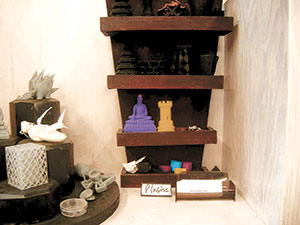
Artisan’s Asylum is the grateful recipient of a 3D printer, generously donated by Chicago-based Inventables in hopes that the technology will become more accessible to artists in the Somerville area and beyond.
By Douglas Yu
Artisan’s Asylum in Somerville, a non-profit community design and fabrication center, won a free 3D carving machine in a contest from Inventables, a Chicago-based hardware store for designers.
“Inventables decided to give away 50 free 3D printing machines across the United States,” Facilities Manager of Artisan’s Asylum Robert Masek said. “We are a pretty big community. We not only let people use the machines here, but also we teach people how to build machines.”
As part of the effort to make 3D printers more accessible to the public, Inventables CEO Zach Kaplan said, “We believe that to ignite the digital manufacturing revolution, we need to provide free access to these important 3D carving tools to as many people as possible.”
Having access to a 3D printer was once something unimaginable for the general public. When 3D printers were first introduced in 1980s they sold for half a million dollars per machine. Prices went down as they became more popular.
“In the early 2000s, people could buy a 3D printer for 10 to 20 thousand dollars. And now, these open-source machines are available online,” Masek said. “You can pay $300 to $500 for a very good quality 3D printer.”
At Artisan’s Asylum, engineers, artists and craftsmen are working on different projects in their own cubicles, although there are places where they also share ideas, exchange tools and collaborate. Various forms of 3D printer-manufactured products made of metals, plastics, wood and other materials are displayed in the hallway.
One example of this technology is a blue-colored Eiffel Tower made with gooey plastic. It is tiny and delicate, as if it could be crushed by hand. The Eiffel Tower was made by a consumer-grade 3D printer, which creates objects by building up the layers with melted strands of plastic.
“Starters can use real materials like wood and aluminum” to create objects through the software-operated 3D carving machine provided by Inventables, the company tweeted the other day. The software, which Inventables created to facilitate the 3D printing process, is called Easel.
“3D printers are a great tool, but they are not approachable for most people.” Masek explained the disadvantages of traditional 3D printers while he was pointing at a Ping-Pong table-sized carving machine. “It’s complicated and it requires a lot of understanding of math and higher-level machine functions, which are called CAM, Computer Automated Manufacture.”
Traditional 3D printer users are required to store their designs as STL (STereoLithography) files in the computers first before CAM starts processing. They must also program the design process by controlling which part of the object will be cut, how big, how fast and how deep the machine cuts the object.
“Traditional 3D printers are very complicated,” Masek said. “And what’s complicated is how to control the system. It requires a set of motor drivers and the motor drivers control exactly where the stepper motors go.” Stepper motors are employed to move the extrusion head, the part of the 3D printer that builds the final product.
Easel replaces CAM and user controlling process, allowing users to design a flat image on their computers first and preview their designs in 3D. “Easel monitors exactly where the motor drivers tell the steppers go,” Masek said.
When asked whether the new digitally operated 3D printers would take manual jobs away from artists, such as sculptors, Masek thinks they wouldn’t. “It’s just another tool in their toolboxes,” Masek said. “They have different bunches of scalpels, cutters and chisels. This is just another tool. Unless you can create the data, you still won’t be able to be an artist by superseding the data creation.”















Reader Comments